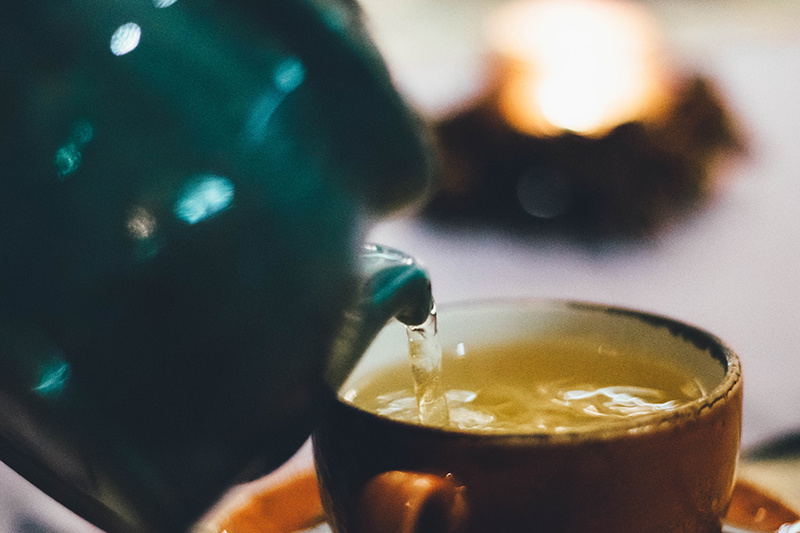Pouring boiling tap water over some tea leaves may sometimes be enough to get a tasty cup, especially with some herbal teas or flavored black tea blends. But try using the same method to make a cup of green tea, and it probably won’t be the cup you will look forward to drinking. Thankfully, brewing a perfect cup of organic green tea is not difficult at all.
What is the difference between organic and non-organic tea?
Let’s first see what the main difference between organic and non-organic tea is. Organic tea is tea grown following a specific set of principles that should preserve both the ecosystem and provide healthier and safer tea. Instead of using harmful chemicals, pesticides, fertilizers and herbicides, tea producers are using natural products to both protect tea plants and help them grow healthy and strong.
Studies showed that tea leaves fertilized using organic fertilizers may have a higher level of polyphenols than non-organic teas [1]. Not only may organic teas provide more antioxidants, but they should be free of harmful chemicals too. The way tea is grown will have a great impact on the flavor too. So, to extract the best flavor and the most benefits from your organic green tea, you will need to brew it properly.
So how to brew a perfect cup of organic green tea?
If you want to enjoy the clean and pure taste of green tea, pay attention to how you are brewing your tea. There are a few rules to follow:
1. Choose water carefully
Always pay attention to water quality. You don’t want to make a cup of high-quality tea with low quality water. Some green teas are very gentle, so always use fresh spring water. Tap water may be too hard for any green tea, and distilled water may make it taste flat. In fact, research showed that catechin content may even decrease in hard water [2].
2. Choose fresh tea
You can’t make a good cup of tea using old stale tea leaves. Make sure your tea is fresh. Some dry tea leaves may not have a strong scent, so check again once you put them into a preheated teapot. Preheat your teapot by pouring hot water into the teapot, swirl it around for a few seconds, then pour it out. Now add tea leaves. They should have a pleasant scent.
3. Add enough tea leaves
Different leaf to water ratios will make tea either strong or weak. 2-3 grams of green tea per cup of water (8 oz) will be enough to make a good cup of tea. Even if you are using smaller brewing vessels, don’t use less than 2-3 grams. Using more tea leaves will not only give a stronger flavor, but more catechins and caffeine too.
4. Choose the best teaware
Choosing the best teaware is as important as choosing the best water. Green tea is gentler than black tea, so always chose a clean teapot or a clean tea infuser. Paper filters or metal infusers may leave a paper or metal taste in your cup. Green tea leaves need less space to expand, so smaller infusers may work well too.

Photo by Maria Tyutina
5. Follow brewing parameters
Never use boiling water for brewing green tea. Studies showed that brewing green tea at 85 ° C (185 °F) for 3 minutes will give both optimum flavor and optimum catechin content [3]. Even though the recommended water temperature for brewing green tea is usually slightly cooler, all high-quality green teas will taste great when brewed at 85 °C.
The exception Is Japanese Gyokuro tea, that’s prepared using much cooler water (and a lot more tea leaves per oz of water). However, steeping green tea for 3 minutes may give a very strong cup. Solution? Keep the first infusion at 1 minute, then re-steep the leaves. You can re-steep almost all green teas two more times.
6. Drink your tea when it’s still hot
The only time when it’s OK to drink cold tea is if you are cold brewing it or making iced tea. Never leave your brewed tea for later.
7. Store loose leaf tea properly
Store your tea properly. Green tea is the most difficult tea to store and can be ruined in a second. Keep it away from direct sunlight, heat, mold, water or strong scents. It’s ok to store unopened tea package in a fridge too, but once you open it, don’t put it back in the fridge.
If you are new to green tea, try following these steps. Once you master the basics, it will be easier to adjust different parameters to prepare the cup you will enjoy the most. Some tea drinkers prefer stronger teas, while others enjoy delicate flavors, so experiment with different types to find the one you enjoy the most. And keep in mind, no green tea should ever taste bitter.
Sources:
[1] https://www.researchgate.net/publication/260960321_Studies_on_Tea_Quality_Grown_Through_Conventional_and_Organic_Management_Practices_Its_Impact_on_Antioxidant_and_Antidiarrhoeal_Activity
[2] M. Cabrera, F. Taher, A. Llantada, Q. Do, T. Sapp and M. Sommerhalter; Effect of Water Hardness on Catechin and Caffeine Content in Green Tea Infusions



I don't think teaware matters. I simply pour hot boiling water into a ceramic cup and dip my teabag into it. After 2 minutes or so I take small sips while working on my desk. However, it takes me 20-30 minutes to finish my cuppa. Is it bad to do that? Should I keep it covered while working? Also, I normally refrigerate green tea in an air-tight container. Is it okay?